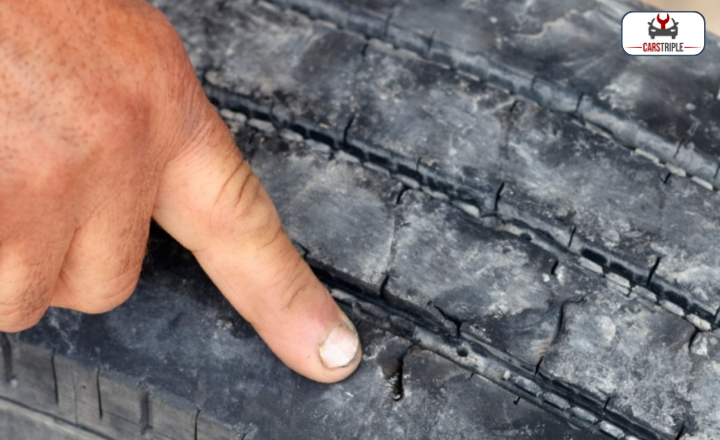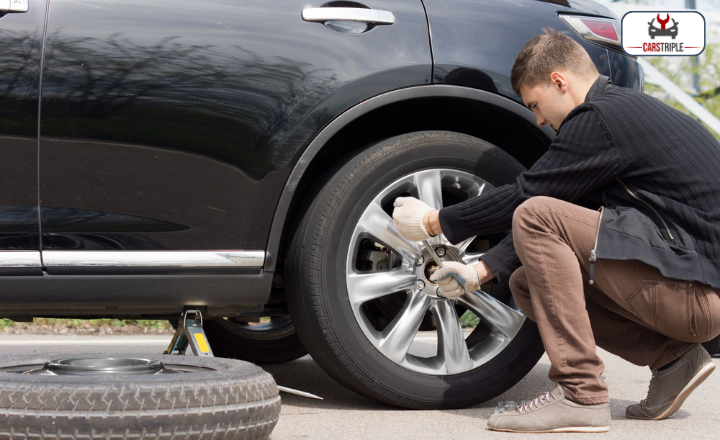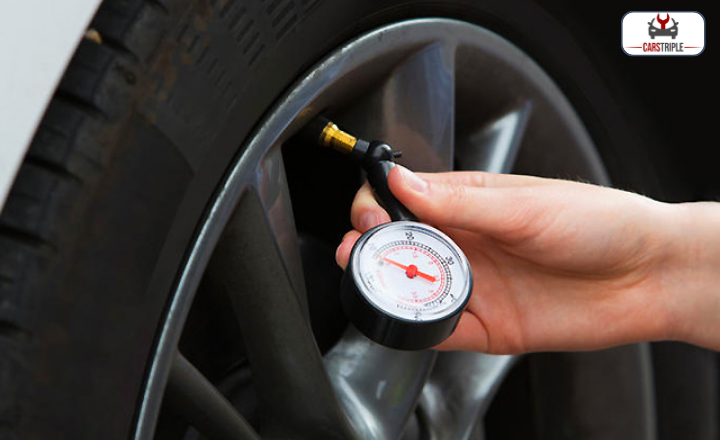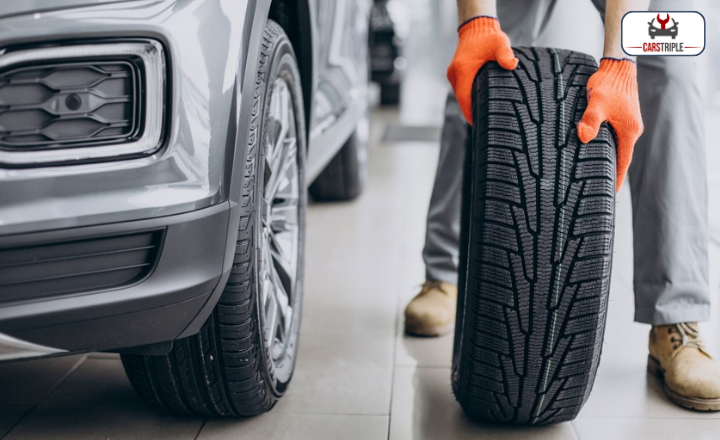Tires work hard on our cars, carrying heavy loads over rough roads and unpredictable weather. Tires can sometimes get holes or damage, and we must choose whether to repair them or buy new ones. This article will discuss tire patch cost, how well they work, and what they mean for your wallet. Let’s get ready for some valuable information on tire patch costs!
How Much Does A Tire Patch Cost?
A tire patch cost usually varies between $15 and $30, depending on how damaged and what kind of tire it is. This is much cheaper than buying a new tire, which can cost anywhere from $100 to over $200, depending on its size and quality.
Most places that fix tires will check yours for free to see if it can be patched or if you need a new one. If your tires are still under warranty, you may not have to pay for these repairs. Some companies offer warranties that cover fixing or replacing a damaged tire. It’s essential to read your warranty carefully to know exactly what it covers.
Why Do Tires Go Flat?
Punctures

Flat tires often happen because of punctures. When a car runs over sharp things like nails, screws, or glass pieces, they can poke holes in the tire. The tire can slowly lose air or burst immediately depending on how big and deep the hole is.
A small leak in your tire may not be obvious right away, but a big hole from a large object can make the tire lose air suddenly. This could be risky if you’re driving fast.
Valve Stem Issues
The valve stem is vital for keeping the correct tire pressure; if it gets damaged or rusty, air can escape and make the tire go flat. This might happen because of wear and tear, not putting it in right, or being in harsh weather.
Check the valve stem for damage or rust if you see your tire losing air. If it keeps happening, think about getting a new valve stem. It doesn’t cost much and is better than driving on a flat tire, which could be dangerous.
Wear and Tear
As time goes by, tires naturally wear out. This happens because the road rubs against the tires and wears down the tread. When the tread gets thinner, your tires can get punctures or go flat more quickly. Some parts might wear out faster than others, if your tires need to be aligned or inflated correctly.

Rotating your tires regularly is an excellent way to deal with this uneven wear. Moving each tire to a different spot on your car now and then makes sure they all get worn out evenly over time. This makes your tires last longer and makes your car work better and safer.
Temperature Changes
Temperature changes can affect your tire pressure a lot. The air in your tires shrinks, and the pressure goes down, when it’s too cold. This can make your tires underinflated and flat if you don’t check them. But when it’s hot, the air expands and the pressure increases. Your tires could wear out faster or burst if it gets too high.
Poor Installation
Improperly installing a tire can make it gradually go flat. If the tire isn’t on the wheel rim correctly, it can wear out unevenly and eventually lose air. This happens because a poorly installed tire can make the car unbalanced when driving, which wears out certain parts of the tire faster.
If not enough air is putted during installation, it can cause a slow leak and lead to a flat tire. Tires with insufficient air get hotter from rubbing on the road more, damaging them over time and causing slow leaks that end in a flat tire.
How To Avoid Getting Flat Tires?

Here are some simple steps to keep your tires from going flat. You have to check your tire pressure regularly, at least once a month or more, if the weather fluctuates. The correct pressure for your tires can be found in the car’s manual or on the driver’s side door post. You should avoid driving over sharp objects and steer clear of areas known for having many short items, like construction zones.
You should regularly inspect your tires for any damage, such as cuts, cracks or bulges, that could lead to a flat tire. Rotate your tires as suggested by the carmaker or every 5,000-8,000 miles to ensure they wear out evenly and last longer. Have your wheels aligned annually to avoid uneven tire wear. Remember to replace old tires when necessary – even with reasonable care, they will only last for a while.
What If You Can’t Use The Tire Patch?

Severe tire damage or a big hole means you can’t use a tire patch. It’s best to replace the whole tire for safety. Driving on a damaged tire is risky and could cause a dangerous blowout and an accident. It may seem expensive to replace the tire, but it’s worth it for your safety. Trying to fix a damaged tire repeatedly could cost more in the long run, with repeated repair costs and potential roadside problems.
How Long Will A Tire Patch Last?
A professional tire patch can last a long time if done right. It seals up the hole tightly to keep air from escaping. If the patch isn’t put on properly, it might not work and could lead to a flat tire. A patched tire can still be used, but it will be better than new. You should check it regularly to ensure the patch is tight and the tire is safe. Over time, regular use or more damage might mean you need a new tire.
How Long Can I Drive With A Nail In My Tire?

The nail can make the tire slowly lose air, affecting how your car handles and wearing out the tire. It might even cause a dangerous blowout. The longer the nail stays in, the bigger the hole, making it harder to fix. If you see a nail in your tire, drive to a tire repair shop carefully because your car isn’t safe.
Is A Tire Patch A Good Idea?
If your tire has a small cut in the tread, using a tire patch can help seal it and stop air from coming out. This will allow you to keep using the tire safely. It’s essential to have a professional check the repair. If your tire has a big hole or damage on the side, it might not be safe to patch it, and you may need to get a new tire instead. You have to regularly check the repaired tire to ensure it’s still safe.
Can You Drive With A Nail In The Tire?
The nail can slowly let air out of the tire, making your car less efficient and more challenging to control. This could cause a blowout, especially if you’re driving fast. If you see a nail in your tire, it’s best to go slowly and carefully to the nearest tire repair shop. Don’t try to remove the nail yourself because it could make things worse and ruin the tire completely.
Is It Better To Plug A Tire Or Patch It?
Plugging and patching a tire both have their benefits. The filling is quick and easy for small holes in the tread, and it can be done in a few minutes without taking the tire off. Patching takes longer but is more secure, especially for more oversized or irregular holes that can’t be plugged effectively. It involves removing the tire, preparing the inside, and sealing a patch to match the inside of the tire.
8 Tire Maintenance Tips
Regularly Check Tire Pressure
Regularly checking your tire pressure is important for your car’s performance and safety. Low pressure can cause problems like using more fuel and wearing out the tires faster. On the other hand, too much pressure can make the tires more likely to get damaged in an accident.

It’s best to check your tire pressure at least once a month before going on long trips. Use a good tire gauge for accurate results. You can find the correct tire pressure in your car manual or on the sticker on the driver’s side door. Following these tips will help your tires work well and last longer.
Rotate Your Tires
Rotating your tires is very important for taking care of your car. It helps to spread out the wear and tear on the tires so they last longer and work well. It’s a good idea to rotate your tires every 5,000 to 8,000 miles, but this might change depending on how you drive and the roads you use.
Look at your car’s manual for the best advice because different cars need different things. When you rotate your tires, you move them around – usually switching front and back tires. This ensures all the tires wear evenly over time and keeps your car running well.
Regularly Inspect for Damage
Regularly inspect your tires for visible damage, such as cuts, punctures, cracks, or bulges. These problems could lead to a flat tire or a blowout while hazardous driving. If you see something like a nail or screw stuck in your tire, don’t try to remove it yourself. Taking it out could cause the tire to deflate quickly, and that’s risky. Instead, go to a professional who can safely remove the object and repair the tire if necessary.
Align Your Wheels
Properly aligning your wheels is essential for your tires and driving performance. If your wheels are out of alignment, it can make your tires wear out too soon and not evenly. This can cause other problems like using more gas, having less control when driving, and having a higher chance of accidents.

If you notice signs like your car pulling to one side or the steering wheel shaking or not straight when driving straight, having your wheels checked and aligned is a good idea. This will make driving smoother and safer, make your tires last longer, and use less fuel.
It’s best to have your alignment checked once a year or whenever you get new tires because everyday things like hitting potholes or curbs can mess up the alignment and make your tires wear out unevenly. Having the proper alignment makes your tires last longer and ensures that your car works well and is safe to drive.
Maintain Proper Tire Balance
Properly balancing your tires makes them last longer and gives you a smoother ride. If your tires are not balanced, they can wear out unevenly, make your car vibrate when you drive, and even cause severe damage. It can also make your car use more fuel and make the parts that hold up your car wear out faster. Balancing your tires means making sure they weigh the same all around. This is usually done by putting small weights on the wheel to balance out any heavy spots.
Monitor Tread Depth
Watching how worn down your tires are is essential because it affects how well your car grips the road, especially in the rain. The penny test is a simple way to check this. If you can see all of Lincoln’s head when you put a penny into the grooves of your tire with his head upside down, it means your tires have worn out and need to be replaced. Checking your tire tread regularly helps you stay safe on the road and reduces the risk of accidents from sliding or skidding.
Load Vehicles Correctly
Overloading your vehicle can put too much pressure on your tires, making them fail. Following the weight limit in your vehicle’s manual or the label inside the driver’s door is essential. This is because each car and its tires are made to carry a certain amount of weight. Also, it’s necessary to spread the weight evenly on all four tires.
Replace Old Tires

It’s essential to change old tires, even if they look okay. The rule is to get new tires every six years, no matter how much they’ve been used, but definitely after ten years. This is because rubber wears out over time, and old tires can be dangerous, even with good tread.
You can find the date your tire was made on the side, so always check to ensure they’re still young. Changing old tires regularly isn’t just about keeping your car in good shape; it’s also about staying safe on the road. Old or worn-out tires can cause accidents by blowing out or not gripping well, especially in bad weather.
Can I Patch My Tire Myself?
You can fix your tire if you have the right tools and know-how. But it’s only a good idea if you have experience. It would help if you were careful and skilled to do it right. If you do it wrong, your tire could go flat or even blow out, which is dangerous. Let a professional fix your tire better because they have the right skills and tools. It’s safer to let the pros handle it unless you’re confident or trained.
Can I Drive On A Flat Tire?
Driving on a flat tire is not a good idea because it can mess up your car and be dangerous. Going on a flat tire can wreck the tire, harm the wheel, or mess up the suspension. It also makes it challenging to steer and raises the crash risk. If you get a flat tire, it’s best to stop safely and change the tire if you have a spare or call for help immediately.
What Is A Run-Flat Tire?
Run-flat tires are made to keep working even if they get a hole, so you can keep driving for a while before changing the tire. They have strong sides that can hold up the car without air. You can go on a flat, run-flat tire for about 50 miles at 50 mph.
These tires are good because they make driving safer and easier since you don’t have to stop immediately to change a tire in the wrong place. But they cost more than standard tires; not all places can put them on your car. Also, if a run-flat tire gets a hole, you usually can’t fix it and must get a new one.
How Often Should I Replace My Tires?
Tire replacement depends on the tire quality, how you drive, the weather, and road conditions. Usually, tires need to be changed every 25,000 to 50,000 miles. But it’s important to check them regularly for wear or damage because they might need replacing sooner if worn out or damaged. Changing a tire every six to ten years is a good idea, even if it seems fine. This is because rubber becomes weaker over time and can impact the tire’s performance and safety.
What Are The Signs That My Tires Need To Be Replaced?
Your tires need to be replaced if you notice a few things. First, if the tread wear is down to 2 32 of an inch, it’s time for new tires. Also, look for any cuts, cracks, or bulges on the tire. These could cause tire failure if not fixed right away.
If you often lose air pressure in your tires or feel strange vibrations and thumping while driving, it’s time for new tires. And even if they look okay, any tire that is ten years old should be replaced just to be safe. Keep an eye out for these signs so you can return your tires on time and stay safe on the road.
Do All Four Tires Need To Be The Same?
For the best performance and safety, it’s essential to have all four tires on a vehicle that are the same size, type, speed rating, and load index. Having identical tires helps the car handle better and be more stable.
Many vehicle systems like ABS and ESC are made assuming that all four tires are the same. Using different tires can confuse these systems and make them less effective. If your vehicle is AWD, having other tires can cause extra wear on the drive train, leading to more repairs and higher maintenance costs.
Conclusion
To sum up tire patch cost, repairing a tire can vary in price depending on the extent of the damage, your location, and the person doing the work. The cost usually falls between $10 and $20. It’s essential to address tire issues promptly to avoid more severe problems down the road. Ensure your car is safe to drive. If you believe your tire needs repairing, contact a nearby auto shop as soon as possible.
FAQ’s
Will a patched tire last as long as a new one?
A properly patched tire can last just as long as before the damage occurred, as long as it’s done correctly and the puncture is within repairable limits.
Is getting a tire patched safe?
Getting a tire patched is safe and reliable when it is done correctly. It allows you to continue using your existing tires without having to replace them entirely.

